mistory
A Celebration of Sight
with Mercy Ships
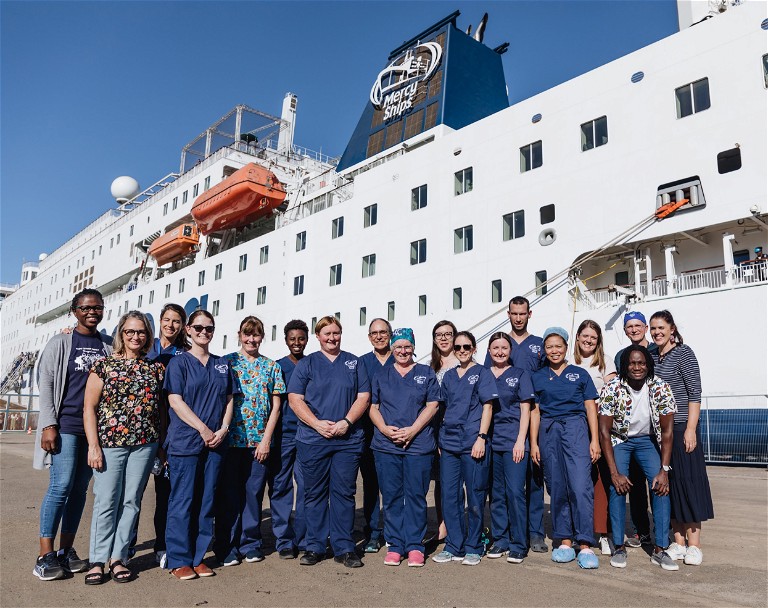
Mercy Ships leadership team.
WRITER Ella Hawthorne
Had you told Ella Hawthorne a year ago that she would be quitting a job that she adored, and moving to the opposite side of the world to live on a ship for the next two years, she would have said you were crazy.
So what is she doing packing up all her belongings, selling her car, and heading to Sierra Leone to re-board a Mercy Ship that she now calls home?
Mercy Ships, founded in 1978, is a unique international non-government organisation that uses hospital ships to deliver free, lifechanging surgical care to those who cannot afford it, as well as surgical education for our African medical colleagues.
These ships have a legacy of bringing hope and healing to patients across the world, focussing their work in sub-Saharan Africa since 1990. According to the Lancet Commission on Global Surgery conducted in 2015, five billion people worldwide lack access to safe, affordable, timely surgery. This proportionally affects low- and middleincome countries much more than moredeveloped nations. An even greater issue is that the density of surgical specialists in sub-Saharan African countries is well below the recommended 20 per 100,000, sitting at somewhere between 0.2 and 1.0 per 100,000.
Lack of access to surgery is a life-threatening problem. In 2010, an estimated 16.9 million people died due to unmet surgical needs. This is more than all of the annual deaths due to HIV/AIDS (1.46 million), tuberculosis (1.2 million), and malaria (1.17 million) put together. Because around 40% of the world lives within 100km of a coast, a ship is an excellent way to deliver aid. By allowing an entire hospital to be relocated from one country to another, it allows for stability and consistency of facilities, and provides a platform for training and education of local healthcare providers.
A LIFE-CHANGING AWAKENING
My journey to join Mercy Ships has been over a decade in the making, and ultimately directed the trajectory of my career. Being a regular participant – and eventual organiser – of the 40 Hour Famine, I learnt how lucky I was to be born into a family that could afford clothes for myself and my brother, food on the table every day, and a warm, dry home.
I started to learn more about our healthcare system, especially due to an accident-prone younger brother, and was struck by how privileged we are to have a governmentfunded healthcare system that works to take care of us when problems arise.
This world-altering awareness made such an impression on me that since my early teens I have wanted to use the privilege of my education and birthright to help those less fortunate, either in New Zealand or internationally. It was this same desire that ultimately led me to pursue a career in healthcare. Although my original plan to study medicine didn’t work out, I fell into optometry and haven’t looked back.
During my six years working in private practice in beautiful Taranaki, on the western side of New Zealand’s North Island, I have been honoured to serve patients from all walks of life and invest in my local community through my church, local theatres, and as President of the Taranaki Young Professionals.
In 2019, I went on a week-long trip to Vanua Levu in Fiji with Volunteer Ophthalmic Services Overseas (VOSO) and was able to witness the joy and gratitude felt by patients who otherwise would not have had access to eye care. This reaffirmed my desire to serve overseas long term and triggered my Mercy Ships application.
A STEP INTO THE UNKNOWN
In January this year I took my first leap of faith and boarded the Global Mercy, the newest hospital ship for Mercy Ships, which is the largest civilian hospital ship in the world. Following a three-year COVIDinduced hiatus for the Eye Program, I took up the challenge of being the Ophthalmic Team Manager for the Global Mercy’s first full field service in Senegal. Over six months I was stretched and challenged in ways I could never have imagined, had seemingly unrelated skills combined in surprising ways, and ultimately discovered a role and workplace that is incomparable.
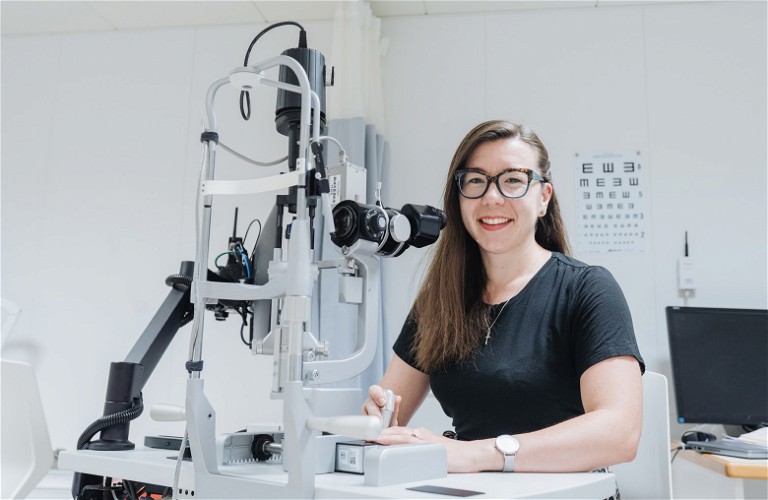
Ella Hawthorne
THE OPHTHALMIC PROGRAM
The Mercy Ships’ Ophthalmic Program aims to serve patients who are classified as blind by World Health Organization standards. It also aims to prevent people from being classified as blind, by performing surgery to improve or protect their vision.
The program’s main focus is helping patients with dense, bilateral cataracts, with a secondary focus on pterygium and other sight-threatening visual conditions. At our patient screening, known as ‘patient selection’, we see hundreds of patients searching and hoping for solutions to vision problems. Each screening location is different and provides its own challenges; a climb up two flights of stairs, or a single, noisy room for our whole screening process, or multiple small rooms across a compound that gets very muddy during a torrential rainy season. We adjust, adapt, and make each new location work.
“ I was stretched and challenged in ways I could never have imagined… and ultimately discovered a role and workplace that is incomparable ”
The days start early and tend to end late. Our screening involves a basic initial check with a pen torch, followed by visual acuity (VA) and intraocular pressure testing, and an assessment with a direct ophthalmoscope and hand-held slit lamp. It is a simple set up that provides most of the information we need to decide about surgery, with a few additional measurements or extra tests to be confirmed on the ship.
While we can’t offer everyone surgery, we give each person standing in front of us our time, attention, and personalised advice.
The most difficult part of my entire Mercy Ships journey has been having incredibly hard ‘No’ conversations. These particularly difficult conversations cover a myriad of causes, such as corneal scars, untreated uveitic scarring and its associated cataracts, eyes with no light perception, and most devastatingly, endstage glaucoma. It is heartbreaking to have to explain to these patients that sadly, there is major damage to their eyes and unfortunately, there is nothing we can offer them. For these patients all we can do is pray.
In contrast, ‘Yes’ conversations are happy and easy. Identifying excellent surgical candidates is a joyful moment, knowing how much they and their families will benefit from a relatively short, life-changing, free surgery.
ABOARD THE GLOBAL MERCY
The Eye Clinic on board the Global Mercy is a busy place. The ophthalmic provider (therapeutic optometrist or ophthalmologist) and ophthalmic technician work to assess the patients’ suitability for surgery, which allows the ophthalmic surgeons to perform more operations.
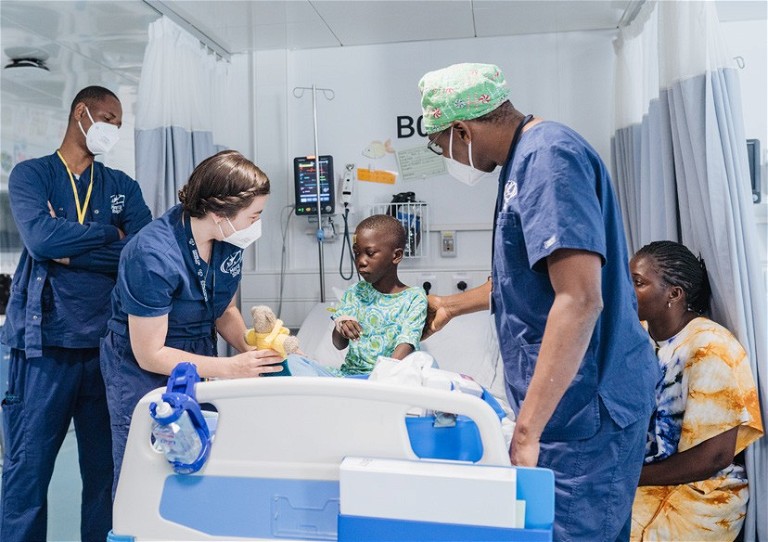
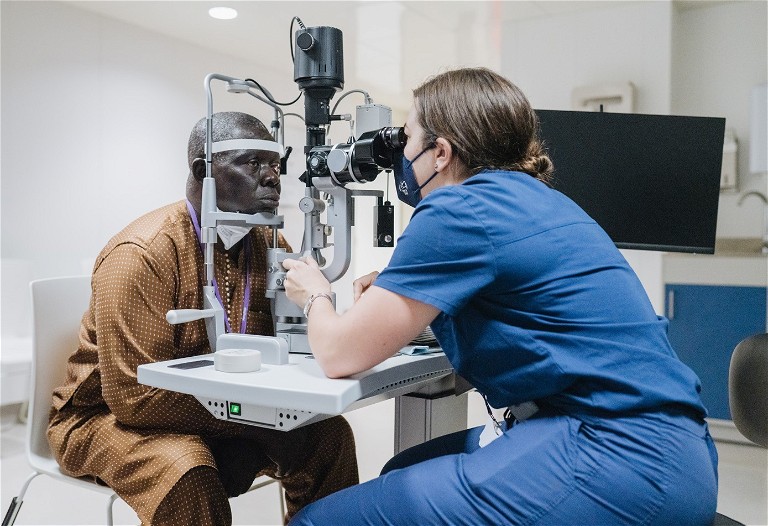
Patients are first seen on board for their final pre-operative assessment, including intraocular lens calculations using a combination of A-scan axial lengths and K readings.
On indication we perform a dilated fundus exam, although more often than not the cataracts are far too dense to see through. In that case we would likely do a B-scan ultrasound to ensure that the retina is still in place before confirming a final ‘yes’ to surgery. The team looks for anything that might make the surgery or recovery more complicated to alert the surgeon, including systemic conditions such as hypertension or hyperglycemia assessed by our scheduling nurse.
Cross-cultural communication is a big challenge. Thankfully we have incredible day crews, local people who volunteer to serve their community in various roles across the whole ship. In the Eye Clinic, their primary role is as translator, both for language and cultural context. They are critical to every step of our clinical flow. They also attempt to teach us some of the local language. The impact of being able to greet someone and introduce yourself in their language is phenomenal and immediately helps to build rapport with patients. I highly encourage any healthcare providers to try to learn a few greetings from other cultures and languages, especially those that you interact with on a regular basis.
Our day crew members readily share their culture and lives with us, as we in turn share our culture with them and teach them about eyes. When teaching our Senegalese day crew how to guide patients with reduced vision, I was struck by how emotionally affected they were from that small period without sight. I am incredibly grateful for my sight, especially when interacting with patients with vision loss, but I don’t necessarily think about how significant it is every day. It was refreshing to be reminded of its importance while teaching our day crew a critical skill to look after our patients, especially when they return on the day of surgery.
“ It is heartbreaking to have to explain to these patients that, sadly, there is major damage to their eyes and unfortunately there is nothing we can offer them ”
SURGICAL OPTIONS
The main surgical technique used on board is multiple small incision cataract surgery (MSICS). This technique has rapidly become the most commonly-used cataract surgical technique in developing nations. It does not need stitches, unlike its predecessor, extracapsular cataract extraction (ECE), and does not rely on more modern, expensive equipment like phacoemulsification, which also has a higher cost per surgery due to consumables. The cost of equipment and ongoing supply of consumables are huge barriers for many ophthalmic surgeons in low- and middle-income countries, as well as the ongoing maintenance of such machines.
All of these reasons explain why MSICS has become such a popular technique, and why this technique is taught to trainee surgeons who come on board as part of the Mercy Ships Education, Training, and Advocacy (ETA) program. It would be such a waste of a trainee’s time and of other resources to train someone in a technique that they wouldn’t be able to use when returning to their clinic. There is, however, a phacoemulsification machine on board, as well as the ability to perform anterior vitrectomies. This is particularly important for our paediatric patients, or for other more complicated procedures. It is a luxury to have two operating theatres designed for ophthalmology on board, and to be able to offer both major surgical techniques within our ophthalmic program.
POST-OP
After surgery, our patients return for routine follow-up appointments in the Eye Clinic at one day, two weeks, and six weeks. Obviously, they may also return sooner if they are having any issues with their eyes, and our ophthalmic provider will assess them and bring in the surgeon if required. One day follow-ups are a special time with patch removal. There are sometimes tears, and laughter, or times of prayer and thanksgiving. Along the way we hear small snippets of their stories, but our favourite time to hear patients’ stories is at their six-week follow-up.
Due to the prevalence and likelihood of patients developing posterior capsular opacification (PCO), we perform a YAG laser capsulotomy for every patient at their six-week follow-up, so they don’t have to deal with that problem in the future.
We also have an incredible event called the ‘Celebration of Sight’. This is where we truly hear about the impact we have on an individual level. It is a time of singing, dancing, and celebrating with patients and their families. Some patients tell us about the difference that surgery has made for them.
CHANGING LIVES
A few of these stories especially stand out for me. One is of an 18-year-old boy who had been adopted along with his siblings. His vision had slowly deteriorated over the previous five years, and he developed bilateral cataracts with VA of 6/60 or counting fingers. We are not sure what caused that to happen. At both his pre-operative assessment and during the surgery his prognosis was marked as potentially poor, however, miraculously, his day one unaided VA was 6/12!
The surgeon was so surprised and delighted that he made the call to operate on the other eye, which is not our normal protocol, and had a similar outcome. Another is an outcome that wasn’t as good on paper, but the impact was just as significant. We saw a gentleman with a significant cataract and counting fingers vision in both eyes. We performed surgery for him, and his vision only improved slightly to a fluctuating 6/60 due to posterior problems we were unable to predict.
At his ‘Celebration of Sight’, he arrived with a large parcel. He and his family came to me, to gift a painting to the Eye Clinic. He explained that for the past 10 years all he could really see was shadow and light, but now he could see colour again. Even though his vision wasn’t perfect, his hope and joy had been restored.
One final story is of a woman who lived with her sister and family, and absolutely loved to cook. Food was the way she showed love to her family. As her vision deteriorated, so did her cooking, up to the point that her sister banned her from cooking after she mixed up the salt and sugar one too many times. It had been years since she was able to cook, and following surgery she was able to express her love and take care of her family again.
THE CHALLENGE AHEAD
We hear versions of these stories, although maybe slightly less extreme, in our clinics every day. For Australasian optometrists and ophthalmologists, ophthalmic surgical waiting lists and waiting times across Australia and New Zealand are currently an issue forefront of our collective minds. We are keenly aware of the negative affect on quality of life of many eye conditions and we are working to reduce the burden of disease for as many patients as we can. Especially given our ageing population, this is a challenge that the ophthalmic community must all work towards together.
“ … the ‘Celebration of Sight’… is a time of singing, dancing, and celebrating with patients and their families ”
By latest estimates there are 3.4 and four ophthalmologists per 100,000 people in New Zealand11and Australia, 22respectively. While ophthalmologists are in high demand and this may seem like a small number, we are actually incredibly fortunate to have that level of specialists.
In Sierra Leone, where the Global Mercy is currently serving, there are only six ophthalmologists for the entire population of 8.4 million people. The limited number of surgeons are under an incredible amount of pressure with busy clinics every day. Just imagine how long their waiting lists are!
Patients face other challenges, such as financial barriers, as even at government or mission hospitals they still have to financially contribute to their exam, treatment, and surgical costs, as well as transport to and from the hospital.
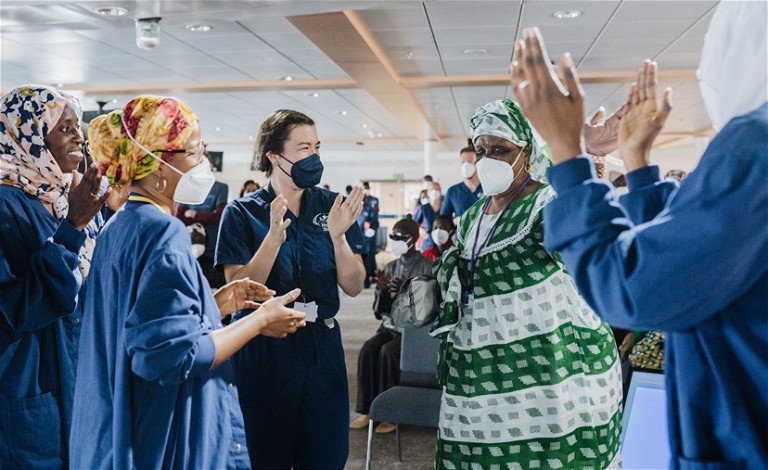
Patient education is also a huge challenge, as we meet many patients who have visited an ophthalmic provider but did not fully understand their eye condition or the treatment they had been given.
Sierra Leone is working to increase the number of ophthalmologists in the coming years, with two currently in training. This is why partnerships with organisations like Mercy Ships are so critical, to build up and train up the local healthcare providers, so that ideally we are no longer needed.
I look forward to the day when that is the reality.
Ella Hawthorne is a University of Auckland trained therapeutic optometrist. She worked at Judd Opticians in New Plymouth, New Zealand for five years where she helped to develop dry eye and myopia control clinics. Ms Hawthorne is currently serving as the Ophthalmic Team Manager for Mercy Ships, providing free eye surgeries in sub-Saharan Africa.
References
1. Royal Australian and New Zealand College of Ophthalmologists, RANZCO's vision for Aotearoa New Zealand's Eye Healthcare to 2030 and beyond (Version 1) avail at: ranzco.edu/wp-content/uploads/2023/05/NZ-Vision-2030_FINAL.pdf [accessed 12 Sept 2023].
2. Australian Institute of Health and Welfare, Eye Health: Treatment and management (webpage), avail at: aihw.gov. au/reports/eye-health/eye-health/contents/treatment-andmanagement [accessed 8 Sept 2023].
Partnering with African Nations
Mercy Ships operates hospital ships that deliver free surgeries and other healthcare services to those with little access to safe medical care. An international faith-based organisation, Mercy Ships has focussed entirely on partnering with African nations for the past three decades. Working with in-country partners, Mercy Ships also provides training to national healthcare professionals and supports the construction of in-country medical infrastructure to leave a lasting impact. Each year, more than 3,000 volunteer professionals from more than 60 countries serve on board the world’s two largest non-governmental hospital ships, Africa Mercy and Global Mercy. Professionals, such as surgeons, dentists, nurses, health trainers, cooks, and engineers dedicate their time and skills to accelerate access to safe surgical, obstetric, and anaesthesia care. Founded in 1978, today Mercy Ships has offices in 16 countries including Australia and New Zealand, and an Africa Service Centre in Dakar, Senegal. For more information visit mercyships. org.au or mercyships.org.nz and follow the organisation on social media.